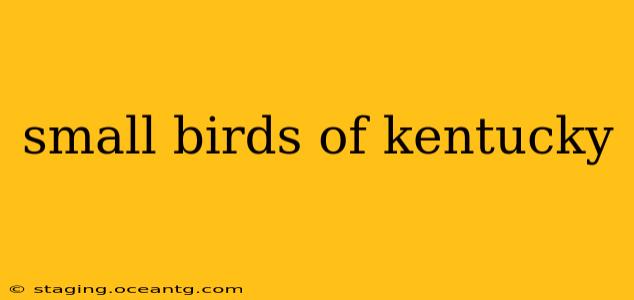Kentucky, with its diverse habitats ranging from lush forests to sprawling grasslands, is home to a vibrant array of avian species. While many birdwatchers focus on the larger, more easily spotted birds, the smaller species offer a fascinating world of intricate beauty and complex behaviors. This guide explores some of the smallest birds you can find in the Bluegrass State, providing identification tips and insights into their fascinating lives.
What are some of the smallest birds in Kentucky?
This is a question with many answers, as "small" is relative! However, some consistently tiny and frequently sighted birds in Kentucky include:
- Ruby-crowned Kinglet: These tiny dynamos, barely larger than a hummingbird, are known for their vibrant ruby-red crown patch (often hidden). They're incredibly active and flit through the trees searching for insects.
- Golden-crowned Kinglet: Similar in size to their ruby-crowned cousins, these kinglets are slightly larger and boast a bright yellow crown stripe. They, too, are energetic insect hunters.
- House Wren: These busy little birds are common in gardens and around human dwellings. They have a distinctive, loud song and are known for their aggressive territorial defense.
- Brown Creeper: These tiny, brown birds are masters of camouflage, blending seamlessly with tree bark. They spiral upwards along tree trunks searching for insects.
- Bewick's Wren: Slightly larger than the House Wren, Bewick's Wrens are still considered small and possess a slender body and long, decurved bill, perfectly adapted for foraging insects in crevices.
What is the smallest bird in Kentucky?
Pinpointing the absolute smallest bird in Kentucky is challenging due to slight variations in size within species and occasional rare sightings. However, both the Ruby-crowned and Golden-crowned Kinglets are consistently among the smallest and most commonly seen. Their diminutive size is a testament to their remarkable adaptability and survival skills.
Where can I find small birds in Kentucky?
Small birds inhabit various habitats throughout Kentucky. To maximize your chances of spotting them:
- Forests: Look for kinglets and creepers in deciduous and mixed forests.
- Gardens and yards: House wrens and other small passerines are frequent visitors to well-maintained gardens with shrubs and trees.
- Wetlands and riparian areas: Some smaller species thrive near water sources.
- Parks and green spaces: Urban parks and green spaces can provide surprising havens for small birds.
Remember to use binoculars for a closer look and appreciate their delicate beauty from a respectful distance.
What do small birds in Kentucky eat?
The diet of Kentucky's small birds varies depending on the species but generally includes:
- Insects: Many small birds are insectivores, feeding primarily on insects, spiders, and other small invertebrates.
- Spiders: A crucial food source, especially for kinglets and creepers.
- Berries and seeds: Some small birds supplement their diet with berries and seeds, particularly during the colder months.
Their foraging techniques are equally diverse; some glean insects from foliage, others probe bark crevices, and some hover to capture insects in mid-air.
How can I attract small birds to my backyard?
Creating a bird-friendly backyard is a rewarding way to observe these fascinating creatures up close. Consider these tips:
- Provide food sources: Offer a variety of birdseed in feeders, catering to different preferences. Suet feeders are also excellent for attracting insectivores.
- Install a birdbath: Clean water is essential, particularly during hot weather.
- Plant native shrubs and trees: These provide shelter, nesting sites, and natural food sources.
- Avoid pesticides: Chemicals can harm both birds and their food sources.
- Provide nesting boxes: Appropriate sized nesting boxes can encourage birds to nest in your yard.
By following these guidelines, you'll increase your chances of attracting a vibrant community of small birds to your backyard, offering endless hours of fascinating observation and enjoyment.
Author: [Your Name/Website/Credentials - Add your expertise here to build credibility. For example: Avid birder and naturalist with 15 years of experience observing Kentucky birds.]
